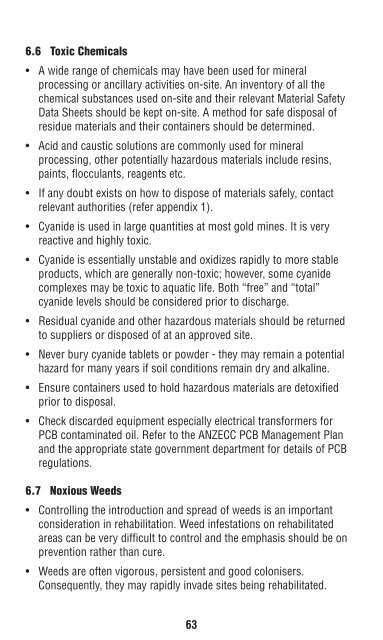Mine Rehabilitation Handbook - Mining and Blasting
Mine Rehabilitation Handbook - Mining and Blasting
Mine Rehabilitation Handbook - Mining and Blasting
Create successful ePaper yourself
Turn your PDF publications into a flip-book with our unique Google optimized e-Paper software.
6.6 Toxic Chemicals<br />
• A wide range of chemicals may have been used for mineral<br />
processing or ancillary activities on-site. An inventory of all the<br />
chemical substances used on-site <strong>and</strong> their relevant Material Safety<br />
Data Sheets should be kept on-site. A method for safe disposal of<br />
residue materials <strong>and</strong> their containers should be determined.<br />
• Acid <strong>and</strong> caustic solutions are commonly used for mineral<br />
processing, other potentially hazardous materials include resins,<br />
paints, flocculants, reagents etc.<br />
• If any doubt exists on how to dispose of materials safely, contact<br />
relevant authorities (refer appendix 1).<br />
• Cyanide is used in large quantities at most gold mines. It is very<br />
reactive <strong>and</strong> highly toxic.<br />
• Cyanide is essentially unstable <strong>and</strong> oxidizes rapidly to more stable<br />
products, which are generally non-toxic; however, some cyanide<br />
complexes may be toxic to aquatic life. Both “free” <strong>and</strong> “total”<br />
cyanide levels should be considered prior to discharge.<br />
• Residual cyanide <strong>and</strong> other hazardous materials should be returned<br />
to suppliers or disposed of at an approved site.<br />
• Never bury cyanide tablets or powder - they may remain a potential<br />
hazard for many years if soil conditions remain dry <strong>and</strong> alkaline.<br />
• Ensure containers used to hold hazardous materials are detoxified<br />
prior to disposal.<br />
• Check discarded equipment especially electrical transformers for<br />
PCB contaminated oil. Refer to the ANZECC PCB Management Plan<br />
<strong>and</strong> the appropriate state government department for details of PCB<br />
regulations.<br />
6.7 Noxious Weeds<br />
• Controlling the introduction <strong>and</strong> spread of weeds is an important<br />
consideration in rehabilitation. Weed infestations on rehabilitated<br />
areas can be very difficult to control <strong>and</strong> the emphasis should be on<br />
prevention rather than cure.<br />
• Weeds are often vigorous, persistent <strong>and</strong> good colonisers.<br />
Consequently, they may rapidly invade sites being rehabilitated.<br />
63<br />
• Each State <strong>and</strong> Territory has legislation relating to weed control <strong>and</strong><br />
lists of declared weeds – a list of declared weeds should be obtained<br />
from the relevant State/Territory department (An indicative list of<br />
species declared in some, not all, States is at Appendix 8). The<br />
legislation enables governments to compel l<strong>and</strong>holders <strong>and</strong> occupiers<br />
to control certain weeds <strong>and</strong> to prevent their movement <strong>and</strong> spread.<br />
Failure to control or eliminate these weeds is an offence under the<br />
relevant State/Territory act. Most of the declared weeds are<br />
agricultural weeds. Many other species, including grasses <strong>and</strong><br />
legumes used in agriculture, can be considered environmental weeds.<br />
• Weeds in areas adjacent to those disturbed by mining should be<br />
controlled to reduce the potential seed load. Be sure the mine site<br />
does not become a source of weeds for possible infestation of<br />
adjacent properties.<br />
• Care must be taken to ensure that weeds are not introduced to the<br />
area in topsoil, hay, mulch or manure or as contaminants in seed of<br />
the desirable species. There are many examples of plant species that<br />
have become weeds after being knowingly or unwittingly introduced<br />
into Australia <strong>and</strong> this possibility should always be considered when<br />
introducing exotic species in a rehabilitation program.<br />
• Clean equipment coming on to site from other areas to remove seed<br />
or plant pathogens.<br />
• Fertilisers <strong>and</strong> manures should always be used carefully as they can<br />
stimulate weed growth, seed set <strong>and</strong> spread. A vigorous cover of the<br />
desirable plant species is often an effective impediment to invasion<br />
by weed species.<br />
• Early detection of weeds before they are well established can<br />
simplify their control.<br />
• Cultivation, h<strong>and</strong> weeding, burning <strong>and</strong> herbicides can all be used in<br />
attempts to control weed infestations. However, control can be<br />
difficult where desirable plants are growing amongst the weeds.<br />
H<strong>and</strong> weeding is expensive, but can be effective for smaller areas.<br />
• Selective grass herbicides can be used for grass weeds in areas<br />
revegetated with non-grass species. Herbicides can be applied<br />
selectively using wick applicators in some cases, for example, when<br />
the weeds are much taller than the desirable species.<br />
64
















